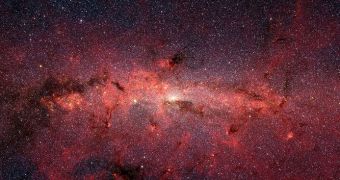The fact that supermassive black holes at the center of galaxies break apart and then consume stars is well known, but experts investigating the Milky Way have now discovered a portion of space at the galaxy's core that features only young stars.
The region is mysteriously devoid of all old stars, astronomers say, which is a very peculiar even in itself. Where have all the old stars gone, they ask.
The mysterious area lies some 25,000 light-years away from our solar system, at the heart of the Milky Way, close to where our galaxy's supermassive black holes must be at.
The dark behemoth is believed to have a mass 4 million times larger than that of the Sun, and experts say it is destroying stars that are unfortunate around to move around it at a high pace.
While investigating the shroud of dust that covers the galactic center, astronomers observed in past studies only the strong blue glow of young massive stars.
They expected however that this light was indicative to the small number of large stars, and that other, older and more massive stars would also emit a more tempered glow.
But three independent research team have recently confirmed that that is not the case, when they discovered that there are actually no old stars in that peculiar region of space.
The investigations were conducted using sensitive infrared telescopes, which are the only tools capable of penetrating the dust shroud, and seeing beyond.
Usually, this type of study reveals hidden stars that lie inside dust cocoons, even if they are very old and dim. But that was not the case when it came to the Milky Way, as none of the three teams found any indications of old red stars.
In a scientific paper published in the latest issue of the esteemed journal Astronomy & Astrophysics, the research teams reveal that the area devoid of old star is about 3 light-years across, and that it lies very close to the center of the galaxy.
The discovery is made even weirder by the fact that all other regions of the Milky Way revealed thousands upon thousands of old stars. The fact that none was found at the core is very weird.
“This would make the region different from all other places we have observed,” explains Rochester Institute of Technology expert David Merritt, who was involved in the studies.
The expert says that developing an explanation for why this situation exists is still very difficult. One possibility may be that the supermassive black hole ate all of the red giants.
“It is hard to make this scenario work” however, Merritt argues. We would need more stellar-mass black holes than can be accounted for by the 1 million solar masses of matter known to exist in the innermost part of the galaxy,” he adds, quoted by NewScientist.

 14 DAY TRIAL //
14 DAY TRIAL //